
Super Mario Bros. 3 is a 1988 platform game developed and published by Nintendo for the Nintendo Entertainment System (NES). It was released for home consoles in Japan on October 23, 1988, in North America on February 12, 1990 and in Europe on August 29, 1991. It was developed by Nintendo Entertainment Analysis and Development, led by Shigeru Miyamoto and Takashi Tezuka.

Pilotwings is an amateur flight simulator video game developed and published by Nintendo for the Super Nintendo Entertainment System. The game was originally released in Japan in December 1990, shortly after the launch of the Super Famicom in the country. It was also released as a launch title for the SNES in August 1991 in North America, with a European release following in 1992.
The Wars series, also known as Famicom Wars and Advance Wars, is a series of military-themed turn-based strategy video games, predominantly developed by Intelligent Systems and published by Nintendo. The series debuted in Japan in August of 1988 with the original Famicom Wars, followed by sequels on the Super Famicom and Game Boy. These early installments were released in Japan, with Advance Wars (2001) being the first to reach the North American and European markets. Advance Wars was released in the United States on September 10, 2001, but put on hold in Japan and Europe due to the September 11 attacks. Although released in Europe in January 2002, neither Game Boy Advance game was released in Japan until the Game Boy Wars Advance 1+2 compilation, which released for the Game Boy Advance on November 25, 2004. The success of Advance Wars in the West is frequently credited as a driving force for Nintendo bringing Intelligent Systems' franchise Fire Emblem outside of Japan, as both series share a similar tactical gameplay style.
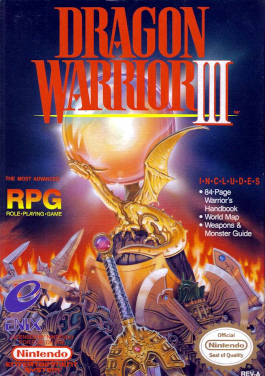
Dragon Quest III: The Seeds of Salvation, titled Dragon Warrior III when initially localized to North America, is a 1988 role-playing video game developed by Chunsoft and published by Enix. It is the third installment in the Dragon Quest series and was first released for the Family Computer (Famicom) in Japan and later for the Nintendo Entertainment System (NES) in North America. The game saw an enhanced remake for the Super Famicom in 1996 and the Game Boy Color in 2001, and a port to mobile phones and the Wii in 2009 and 2011. A version of the game for Android and iOS was released in Japan on September 25, 2014, and worldwide as Dragon Quest III: The Seeds of Salvation on December 4, 2014. It was the first time the game was given an official English subtitle. Later in 2021, another remake of the game titled Dragon Quest III HD-2D Remake, based on Octopath Traveler's style, was announced during the franchise's 35th anniversary livestream.
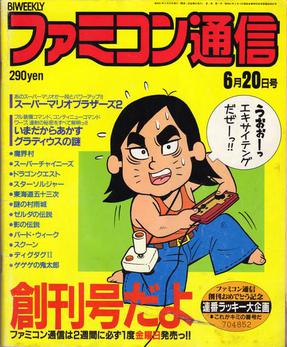
Famitsu, formerly Famicom Tsūshin, is a line of Japanese video game magazines published by Kadokawa Game Linkage, a subsidiary of Kadokawa. Famitsu is published in both weekly and monthly formats as well as in the form of special topical issues devoted to only one console, video game company, or other theme. Shūkan Famitsū, the original Famitsu publication, is considered the most widely read and respected video game news magazine in Japan. From October 28, 2011, the company began releasing the digital version of the magazine exclusively on BookWalker weekly.
1991 saw many sequels and prequels in video games, such as Street Fighter II, Final Fantasy IV, Super Castlevania IV, Mega Man 4, Super Ghouls 'n Ghosts, and The Legend of Zelda: A Link to the Past, along with new titles such as Sonic the Hedgehog, Battletoads, Lemmings, Sunset Riders, Duke Nukem, Fatal Fury: King of Fighters, and Streets of Rage. The year's highest-grossing video game worldwide was Capcom's arcade fighting game Street Fighter II. The year's best-selling system was the Game Boy for the second year in a row, while the year's best-selling home video game was Sega's Sonic the Hedgehog, which was also the year's top video game rental in the United States.
1990 saw many sequels and prequels in video games, such as Metal Gear 2: Solid Snake, Dr. Mario, Dragon Quest IV, Final Fantasy III, Phantasy Star II, and Super Mario World, along with new titles such as Fire Emblem: Shadow Dragon and the Blade of Light and Magic Sword. The year's highest-grossing arcade video games were Final Fight in Japan and Teenage Mutant Ninja Turtles in the United States. The year's best‑selling system was the Game Boy, while the year's best-selling home video game was Super Mario Bros. 3 for the Nintendo Entertainment System.
1988 saw many sequels and prequels in video games, such as Dragon Quest III, Super Contra, Super Mario Bros. 2, Mega Man 2, Double Dragon II: The Revenge, and Super Mario Bros. 3, along with new titles such as Assault, Altered Beast, Capcom Bowling, Ninja Gaiden, RoboCop, Winning Run and Chase H.Q.
1987 saw many sequels and prequels in video games, such as Castlevania II: Simon's Quest, Dragon Quest II, Final Lap, and Zelda II, along with new titles such as After Burner, Contra, Double Dragon, Final Fantasy, Mega Man, Metal Gear, Operation Wolf, Phantasy Star, Shinobi, Street Fighter and The Last Ninja. The Legend of Zelda was also introduced outside of Japan.
1986 saw many sequels and prequels in video games, such as Super Mario Bros. 2, along with new titles such as Arkanoid, Bubble Bobble, Castlevania, Dragon Quest, Ikari Warriors, The Legend of Zelda, Metroid, Out Run and R.B.I. Baseball. The year's highest-grossing arcade video games were Hang-On in Japan, Hang-On and Gauntlet in the United States, and Nemesis (Gradius) in London. The year's best‑selling home system was the Nintendo Entertainment System (Famicom) for the third year in a row, while the year's best-selling home video games in Western markets were Super Mario Bros. in the United States and Yie Ar Kung-Fu in the United Kingdom.
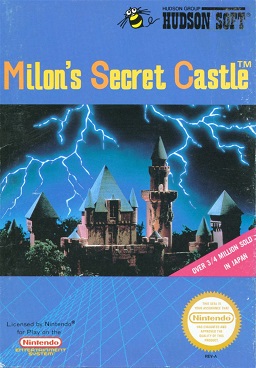
Milon's Secret Castle, known in Japan as Meikyū Kumikyoku: Milon no Daibōken, is a 1986 action-adventure game released by Hudson Soft for the NES. A Game Boy version was released in 1993. A sequel, DoReMi Fantasy, was released in 1996 for the Super Famicom.

Game Boy Wars is a wargame developed by Nintendo and Intelligent Systems and published by Nintendo for the Game Boy in Japan only in 1991. It is a portable follow-up to the 1988 Family Computer wargame Famicom Wars, making it the second game in Nintendo's Wars series. A series of sequels to the original Game Boy Wars were produced by Hudson Soft.

Fire Emblem: Thracia 776 is a tactical role-playing game developed by Intelligent Systems and published by Nintendo for the Super Famicom; it was originally released through the Nintendo Power flash cartridge in 1999, then on a ROM cartridge the following year. It is the fifth installment in the Fire Emblem series, the third and last title to be developed for the Super Famicom, and the last home console Fire Emblem until the release of Fire Emblem: Path of Radiance in 2005.

Karnov's Revenge is a 1994 fighting game developed by Data East, released for the Neo Geo. It is the second game in the Fighter's History series. The game was later ported to the Neo Geo, Neo Geo CD and Sega Saturn home consoles.

Tetris is a puzzle video game developed and published by Nintendo for the Game Boy in 1989. It is a portable version of Alexey Pajitnov's original Tetris and it was bundled with the North American and European releases of the Game Boy itself. It is the first game to have been compatible with the Game Link Cable, a pack-in accessory that allows two Game Boy consoles to link for multiplayer purposes. A remaster, Tetris DX, was released on the Game Boy Color in 1998. A Nintendo 3DS Virtual Console version of Tetris was released in December 2011, lacking multiplayer functionality. The game was released on the Nintendo Switch Online service in February 2023.
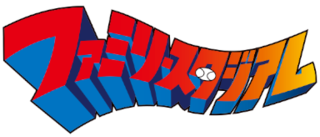
Family Stadium, also known as Pro Yakyū: Family Stadium and Famista, is a series of baseball sports video games initially developed and released by Namco in Japan, and later developed and published by Bandai Namco Entertainment. The first entry in the series, Pro Baseball: Family Stadium, was released for the Nintendo Family Computer in 1986 and later in North America as R.B.I. Baseball, with the series being released on numerous home consoles, the latest being Pro Yakyuu Famista 2020 in 2020 for the Nintendo Switch. The series is considered a precursor to Namco's own World Stadium series of baseball games, released for arcades, PlayStation, and GameCube. The series has been a commercial success since, with over 15 million copies being sold as of 2016.

Metal Slader Glory is an adventure game developed and published by HAL Laboratory for the Famicom in 1991. The game is set in 2062 after humans have colonized the Moon and established several space stations. Earth-based mechanic Tadashi and his girlfriend discover a mech from a war eight years past with an ominous message stored in its memory suggesting Earth is in danger. Tadashi decides to venture to nearby space colonies along with Elina and his younger sister Azusa to investigate the origins of the mech. As Tadashi, the player speaks with other characters and picks dialogue and action commands to advance the narrative.
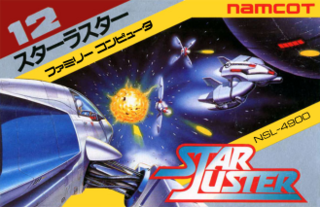
Star Luster is a 1985 space combat simulator video game developed and published by Namco for the Family Computer in Japan. and adapted for play in arcades via the Nintendo VS. System. Star Luster is set in the same universe as Namco's Bosconian (1981), and the gameplay has strong similarities to Atari, Inc.'s Star Raiders from 1979.

Famicom Detective Club is an adventure game duology developed and published by Nintendo for the Family Computer Disk System. The first entry, The Missing Heir, was released in 1988, followed by a prequel released the next year titled The Girl Who Stands Behind. In both games, the player takes on the role of a young man solving murder mysteries in the Japanese countryside.

The Nintendo Entertainment System (NES), an 8-bit third-generation home video game console produced by Nintendo, had numerous model variants produced throughout its lifetime. It was originally released in 1983 as the Family Computer in Japan, with design work led by Masayuki Uemura. Nintendo intentionally redesigned it as the NES in North America in an attempt to avoid the stigma of video game consoles lingering from the video game crash the same year; while it was initially conceptualized as a home computer, it was ultimately modeled after a videocassette recorder (VCR) for its debut there in 1985. Nintendo subsequently exported the NES to Europe and Oceania via local distributors.















